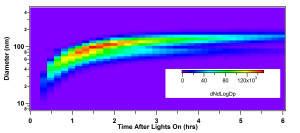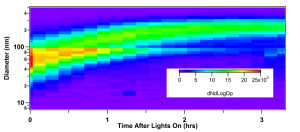The Manchester Aerosol Chamber - Types of Experiment
A systematic programme is currently underway aiming to investigate the formation, transformation, properties and impact of aerosols formed in self-nucleation and seeded experiments. Figure 1 shows the formation of SOA from the nucleation and growth of myrcene photooxidation products as a function of time after lights on (onset of photooxidation). Nucleation of fresh aerosol particles is an atmospheric phenomenon which requires very specific conditions and is only observed in certain environments. Figure 2, on the other hand, shows the more commonly observed formation of SOA by condensation onto pre-existing particles (seed). The presence of seed can often lead to suppression of nucleation as illustrated in the figure for the growth of limonene photooxidation products on pre-existing (NH4)2SO4 seed particles. Such experiments are routinely carried out in our chamber using inorganic as well as characterised, stable, oxygenated organic seed particles.

